The introduction of Light Emitting Diode (LED) bulbs in
the 1960s probably didn’t mean that much to too many people at the time, as the
bulbs were mainly used in technical devices as indicators. In the 70s, LED bulbs
began to appear in electronic calculators, digital wristwatches, and test
equipment.¹ I am
sure that many of us can remember thinking at the time that the red glow of an
LED was one of the most beautiful things we’d ever seen.
With the introduction of additional colors and wavelengths which created even
brighter lighting, more specialized uses have been found for LEDs. In the 90s,
we saw LED bulbs create a niche for themselves in traffic & pedestrian lights,
variable message signs (think Times Square) and automotive lighting.¹
For those that haven’t given it much thought, LED bulbs "are
unique, in that they come in a wide variety of pure colors, all without the
necessity of any type of filter. The color generated by the LED is determined by
the chemical or metal composite that covers the tips of the probes within the
LED itself. One of the reasons that the LED is so efficient is that only a tiny
part of the color spectrum is generated, energy is not wasted generating
unwanted colors." ²
As I was researching this review, I
found a few tidbits²
about LED bulbs that I thought I would pass along, namely:
– LEDs create a natural light. The LED’s soft glow reduces harsh shadows,
reflection and glare.
– LEDs are long lasting. LEDs have a life span of 100,000 hours, or 600 weeks,
or over 11 years of continuous use. Under most applications, LED’s will never
fail.
– LEDs are extremely tough. There is no glass to shatter and no filament to
break, making them completely resistant to shock and vibration!
– LEDs are safe to use. As a general rule, LED’s are excellent to use near
explosive liquids and gasses, or where failed lights can cause accidents.
– Although generally safe to use, LED’s should never be stared at directly by an
unprotected eye because after extended periods of exposure, they can permanently
damage your eyes! Because of this, don’t leave an LED light within reach of
young children who are unaware of the potential harm they can cause if not
properly used.
It’s only been recently that white LEDs have become readily available to
consumers, and I am truly a fan of these bulbs. They produce a
bright white light that burns cool and doesn’t produce an ugly glare. As
a result, manufacturers have recognized their value in consumer devices such as
flashlights and home lighting.
Julie and I have reviewed several of the new LED flashlights in the last
year, and I must say that the battery free ones that have really captured my
interest. A flashlight is only as good as it’s power source, and while an LED
flashlight needs less juice to perform than other types of torches, it still
requires a live power source to produce light. For some reason, the
flashlights that I keep in the glovebox of my car always seem to be dead when I
need them, so a battery free flashlight sounds like a perfect solution – as long
as it lives up to my expectations and is reliable.
Not long ago, I reviewed the
Gadget Brando Battery Free Flashlight and was pleased to find that a
hand-pumped LED flashlight could create a reliable and bright alternative to the
flashlights I had used in the past. Because I have been so satisfied with that
product, when I was offered the chance to take a look at another battery free
version which uses a different power charging source, I was happy to oblige.
Surprisingly enough, I was sent virtually the same product from two
companies, so I will be talking about them both in this review. Both are called
the Forever Flashlight, and except for a few minor cosmetic differences, they
are the same item.
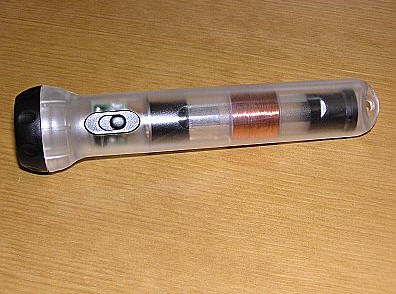
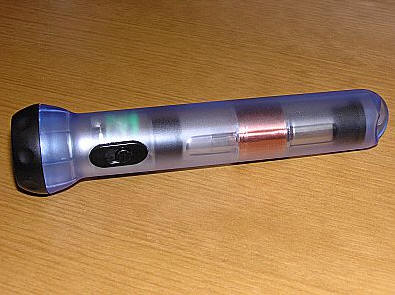
The clear version is available from
Gadget Brando
and the translucent blue model is from
Merconnet
Each flashlight is approximately 6.75" long by 1.75" thick at the lighted
end. There is a sliding off and on switch near the top, and the base has an
integrated lanyard hole. The flashlights weigh approximately 3.5 ounces and
their bodies are composed of sealed translucent plastic which feels solid and
does not flex.
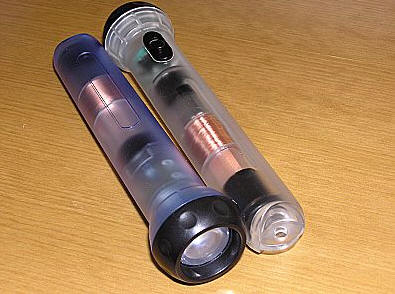
The flashlights are touted as being waterproof and their packaging also says
that they will float, but I honestly wouldn’t chance it. There is an open space
on the clear model where the sliding switch moves and water would be able to
enter the chamber. While this opening isn’t as obvious on the blue version,
there is no no gasket to keep water out.
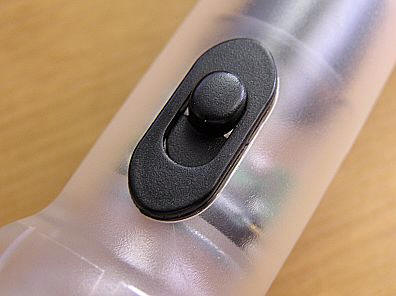
The end cap does unscrew, and the guts of the flashlight are accessible once
it has been undone, but the flashlight is not intended to ever be
user serviced. The bulb should never need replacing and their is no
battery to replace, so unless you just can’t resist it – don’t take the chance
of messing up your flashlight by taking it apart. With that said, after
performing the time tests I couldn’t resist…
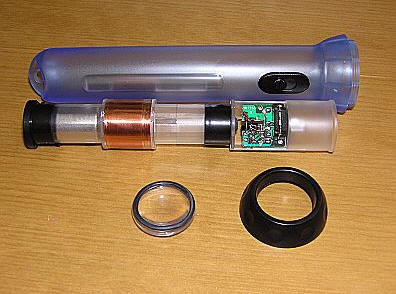
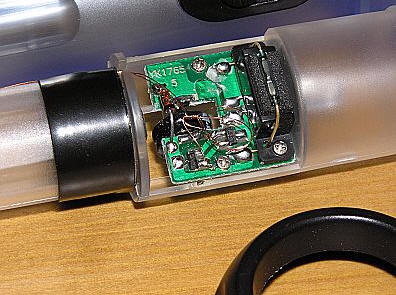
The "guts" of the Forever Flashlight
The flashlight is powered by shaking it with a back and forth motion
, using moderate force, while holding it parallel to the floor. Shaking the flashlight vertically
may damage it, and at the very least will not provide a good charge. The first
time the flashlight is used it will need approximately 90 shakes, but once it
has been powered up first time and a little bit of juice is stored, it won’t
require as much work to keep it going in the future.
According to the packaging, the Forever Flashlight operates on Michael
Faraday’s Law of Induction. In 1831 Faraday observed that,
"whenever the magnetic field about an electromagnet was made to grow and
collapse by closing and opening the electric circuit of which it was a part, an
electric current could be detected in a separate conductor nearby. Moving a
permanent magnet into and out of a coil of wire also
induced a current in the wire while the magnet was in motion. Moving a conductor
near a stationary permanent magnet caused a current to flow in the wire, too, as
long as it was moving." ³
Using this Law, the Forever Flashlight has a
rubber damper at each end of its shaft and a magnet which slides back and forth
inside a copper wire coil, which creates an electrical current. The magnet is
quite powerful, so you will want to make sure that the flashlight is never
stored or held next to the following: pacemakers, cassette tapes, computer
disks, video tapes, credit cards, televisions, any device with a cathode ray
tube (CRT) or automatic wristwatches. You’ve been warned…
The Forever Flashlight is supposed to give more
than five minutes of light when charged (by shaking) for 30 seconds. In
addition, according to the included paperwork "during prolonged use the Forever
Flashlight should be turned off and shaken for 10 to 15 seconds every two or
three minutes."
I tested the clear one first, shaking it back
and forth for a times 120 seconds. This gave me approximately 2 minutes of
bright white light, followed by approximately 2.5 additional minutes of dim
light before the torch died. Hmmmm – not very good.
Next, I charged the blue flashlight for a timed
120 seconds, and I was rewarded with a bright light for all of two seconds, and
then the flashlight died!
Hoping that my results were a fluke, I preformed
the exact same tests an additional time and found…the clear one worked for
about the same length of time, as did the blue. Bleh, by now my arm was starting
to ache and I had nothing to show for it.
I am sure that I am not the only person that
really hates it when a product I am prepared to like a lot doesn’t
meet my expectations, and that is definitely the case with this product. It
would appear that the Forever Flashlight is not reliable, and therefore I can’t
recommend it. Since I happen to have two in my possession that have performed so
poorly, I do not believe my results to be a fluke. I am not going to give up on
finding other battery free LED flashlight solutions, though. I had great results
with the hand-cranked model mentioned previously, and I am sure that there will
be other worthwhile models to follow.
The Forever LED Flashlight is available from
Brando
and from
Merconnet, as well as other retailers.
Price: $15.00
Pros:
Battery Free
Water resistant
Cons:
Strong magnet in base means you must carefully consider storage and placement
locations
Can be damaged if improperly shaken (vertically rather than horizontally)
Light does not stay on for very long at all (mucho effort, no pay-off)
¹ Source:
Marktech
Optoelctronics
² Source:
The LED Store
³ Source:
Engineering.com
ESR for MagSafe Wallet with Stand, RFID Blocking with MagSafe Ring, 5 Card Holder for Phone Case, Slim Leather Magnetic Wallet for iPhone 17/16/15/14/13/12 Series(Not for Mini), Selected Samsung,Black
43% OffTile by Life360 Slim - Wallet Finder, Bluetooth Tracker and Item Locator for Luggage Tags, Passports and More. Both iOS and Android Compatible. Phone Finder. 1-Pack (Black)
33% OffProduct Information
| Price: | 15.0 |
| Manufacturer: | Brando |
| Pros: |
|
| Cons: |
|



Gadgeteer Comment Policy - Please read before commenting
Post your comments here on the Forever LED Flashlight. http://www.the-gadgeteer.com/forever-led-flashlight-review.html Just click the POST REPLY button on this page.
I think you mean that the flashlight should be shaken parallel to the floor, not perpendicular.
Also, this is the first post in which I noticed the sponsored links (like the one that appeared in my sentence above). I think you should put something at the top of every page that disclaims them. Since you provide this site for free and I appreciate it, I’m not going to tell you that you shouldn’t have them, but I do think people need to understand that you (and I) are not endorsing whatever they link to. I know there’s a FAQ link in the ad, but most people won’t click on it.
-Craig
I have corrected the error in the review – thanks for the heads up.
We are experimenting with the sponsored links, and your input is very valuable. Thank you for the excellent suggestion. :0)
Well if you’re looking for feedback, I really don’t like the sponsored links. 🙂 I think they’re tacky, they interrupt the flow of reading, and they’re particularly inappropriate in an objective product review. They kind of say “I’m trying to squeeze every last cent of ad revenue out of this page.” Again, since you’re providing a great public service, I feel bad saying you shouldn’t try to get something for it. I just think the links go a little too far.
-Craig
I gave one of these to my son (10 years old at the time). He got better light performance than your review model. But after about a month, the sealed switch lost alignment… it uses a magnet and sealed reed switch. Once the alignment was off, the switch would not work.
Nice idea, but unreliable on many levels.
Well, we just got a link to what may be a better version – http://shakelight.notanumberinc.com/flashlight/
I am hoping that I can get a review sample, because I love the idea of a shake-powered LED flashlight. :0)
Personally, I despise pop-ups, and spontaneous pop-ups that appear in the middle of reading are the ones that I hate the most. However, there are a lot more people who read your reviews than just those of us who post in the forums from time to time.
Obviously you need some income to keep the-gadgeteer.com going, and since you both have day jobs I am guessing that you don’t have a lot of extra free time to put into the site beyond writing the (most excellent and informative) reviews. Selling advertising is by far the easiest way to do that.
Why don’t you leave the choice of what form of advertising to use up to your readers? Since they are who you will be depending on for your click through per page view rate. Set up a poll that lists every form of advertising that is available to you and link it on the main page. You could even turn this into another useful article since I am sure that most people who have never run a web page have no idea about how web advertising really works, let alone the economics involved.
I myself prefer the path that they took at http://www.penny-arcade.com. Since they hate most web advertising themselves, they were very picky about what they would allow. They went with small (in file size, not footprint) side bar and top bar banner ads that they felt were tasteful (no garish flashing animations) and restricted the content to only products and companies that they felt their audience would be interested in. As a result, they were able to get a much higher than average click through rate and were actually able to charge slightly more than normal per page view.
This is a small part of how (coupled with their astronomical popularity) they were able to turn Penny-Arcade into a viable stand alone business instead of just a really cool side project. I am at least 100 times more likely to click an advertising link from their website than I am from almost any other website. Primarily because the ads don’t aggravate me and they are more likely to be for something I am interested in at the moment.
themog and others:
Let’s please try to stay on topic. If you would like to discuss advertising merits, feel free to email me directly. 🙂
eh.. hehe, I knew I forgot something. 😮 <gomen nasai>
I have seen other products that have been built along the idea of having no battery before. Usually they are fairly clunky, but durable equipment like some of those hand crank world band radios that are usually only purchased by survivalists or by someone who wants something to throw in to their earthquake/flood/teotwawki emergency kits. The reliable ones also tend to be fairly expensive, at least when compared to a normal battery operated unit.
It has only been recently that I have seen cheap and light weight battery free devices like these shaker flashlights. Since you just had two in a row go bad on you, I really question the long term value from a flashlight like this compared to the risk it might pose. The only thing worse than not having the equipment that you need when something goes wrong would be THINKING that you have reliable equipment with you, and acting on that assumption, then finding out that it is broken when you go to use it.
I am sure that eventually we will see durable and reliable “forever” products like these shaker lights that are both reasonably priced and light weight. But trying to sort the wheat from the chaff might be very hard when you only have a couple of weeks to review the product. I think we need some new standards for testing products like this. Some endurance equivalent of the regular “creak test”. Maybe we could give a bunch to a group of overactive cub scouts for a week long camping trip and see how many of them survive the trip intact! 😉
Actually, that could probably be arranged if I could get different flashlights together. My daughter is a Venture Scout and they are going on a 10 day Philmont hike this summer. It might be intersting to see what type of results they had with demanding heavy duty usage. 🙂
I bought a Brando squeeze flashlight based on the merits discussed in Judie’s review, and have found the performance to be excellent – reasonably bright light with a good minute-per-squeeze ratio. I got it for an emergency kit (actually, bought two) and chose it over the shake lights on the simple fact that I the shaking motion to me is more disruptive and annoying to perform than the squeezing action.
One of my squeeze lights out of the box was a bust, however – with just a couple of strong squeezes the pump mechanism snapped. Luckily for me, Eric at Brando helped arrange a replacement.
It might be good to mention that the squeeze-type mechanism can be prone to breaking if squeezed too vigorously, but otherwise, this type of light seems much more reliable than that of the shake-variety.
wondertwinzz – that was something we were talking about in the BB following the squeeze-action review. So far mine is holding up really well, but I think the squeeze action would be the first place for it to break, if it were apt to.
I bought a Hummer “shaker” flashlight from Sharper Image. I know the instructions say to turn off before shaking, but I find if I shake it every so often that you can keep the light going. I have it in my car along with two battery powered flashlights, so it serves only as a backup.
My wife bought her stepfather one of the clear shakers, and I thought it was laughably cheap in construction.
It’s performance was about like yours too.
It survived Christmas day, and pooped out shortly thereafter.
I was dissapointed too.
LOL! Considering the demands of Philmont, I’m not sure that she’ll want to carry what may well end up being dead weight along the trails. In fact, my daughter only carried a small MagLight and rarely even needed that.
On the other hand, Philmont is an EXCELLENT ‘test to destruction’ place- you could even run a booth at the Training Center and the adult Scouters there would certainly be happy to play with any such ‘toys’ till they either break or prove themselves, and probably write some great feedbacks.
I was ready to dial the 800 number and order the Forever Flashlight but then I decided to check it out on the net 1st. Thanks to your review I am about 20 bucks richer.
Ace
They both seem to be Chinese Edi-t flashlites, I payd 10€ of mine (little too much compared to factory prise), 30 seconds of light shaking gives ~2 minutes of light, instruction warns of shaking flashlight hard because it might brake (I guess voltage gets too high for condensator, electrolyte condensators do heal automatically from small damage thou, so this shouldn’t be a problem). I think I better add zener diode to protect condensator anyway. As far as I can tell there is no other braking parts besides condensator, light switch works with small magnet and is 100% waterproof, only way to make it brake is demagnetize it by another magnet or open flashlight and flip circuit board upside down. Summa summarum, follow istructions and don’t open your lamp and everything goes fine.
Ps. this is cheapest and crapiest product of Edi-t, and we are talking about Chinese company so it might be heapest and crapiest of the world. If you want good one you need to pay for it.
Hannu
Wow! There seems to be a serious flaw to the review process you used. First off, anything that produces electricity to save it for later is using some sort of battery to “store” the charge. Second, batteries are either classified as disposable or rechargeable, but in the end All batteries die a permanent death. While alkaline batteries can be recharged with a slow charger for an average of 10 to 20 additional uses (I bought my alkaline battery charger years ago from Sharper Image) the typical rechargeable batteries are quick charge but can give withstand more charges. Thirdly, the rechargeable flashlights use either a typical rechargeable battery or a type of capacitor, which is also a form of a battery. A capacitor can be re-charged many times over, but the dis-charge rate is limited to minutes depending on the size of the capacitor and the electronic circuit controlling the discharge rate. Another popular type of rechargeable item using a capacitor is the mini remote controlled car. You can recharge the can many times and play with it for a few minutes, sometimes as long as 10 to 15 minutes before the capacitor is completely dis-charged. But in all cases, the capacitor has a limited lifespan; eventually it will also lose it’s ability to retain a charge. Currently, I have a Forever Flashlight III by Excaliber that will not retain a charge after three years (if I shake it while holding down the button it still lights up) and a helicopter from Radio Shack that will no maintain a charge. Perfectly good devices with dead batteries!!
I have a Forever Flashlight III by Excalibur. When I leave the switch “on” and set it aside for weeks or even months, and without touching or moving it, I have noticed something very peculiar. There will always be a tiny bit of light being emitted by the LED. How is this possible? I don’t know if the electric storage function is being performed by a capacitor, battery, or whatever, but nothing should be able to hold a charge for that long and continuously emit light. So I am stumped as to how this occurs. In my understanding, the MOTION is converted into electricity when magnetic lines of force and copper wire pass through each other. But there is no motion at all. The flashlight is completely still. So how can it produce a very small amount of light for weeks, or even months, when it is standing still?
@Stephen Well, the battery may not be able to hold enough charge to light the LED normally for that long, but there is a residual charge in a battery for a long time after it becomes “empty” for practical purposes. A barely glowing LED draws so little current that I’m not surprised it could still be on for weeks while the battery slowly drains to zero.
I once had a more traditional LED flashlight that had a standby mode similar to this, and it was still glowing like 2 years after I initially lost it under a chair. I couldn’t see it at that point without my eyes being adapted to the dark, but it was still emitting a tiny amount of light when I found it…
I recently tested one of these LED shake-to-charge flashlights sitting in my glove compartment for years, never used, and found that it took about four minutes of shaking to get it to produce light.
I found this a piece of junk. It never really worked. Put it away in the basement and found it the other day – still does not work – will throw it out – so much for the “Forever Flashlight”!
Hello,
My Forever Flashlight by Excalibur works well, and has for years. The switch does not penetrate the housing so there is no way to leak water that way – instead there is a magnet on the slider which closes a magnetic reed switch inside the casing when I push it on.
LEDs only are “light emitting DIODES” – and diode means it is a semiconductor which only conducts electricity in one direction – but it also only conducts above a certain voltage threshold. So you must charge the capacitor for a little while to reach that voltage before you get any light. It’s not long – just not after two shakes if it’s been sitting for a year.
Mine works fine – I’ve had it for 20 years. With dark-adapted eyes, it’s quite bright enough as well.